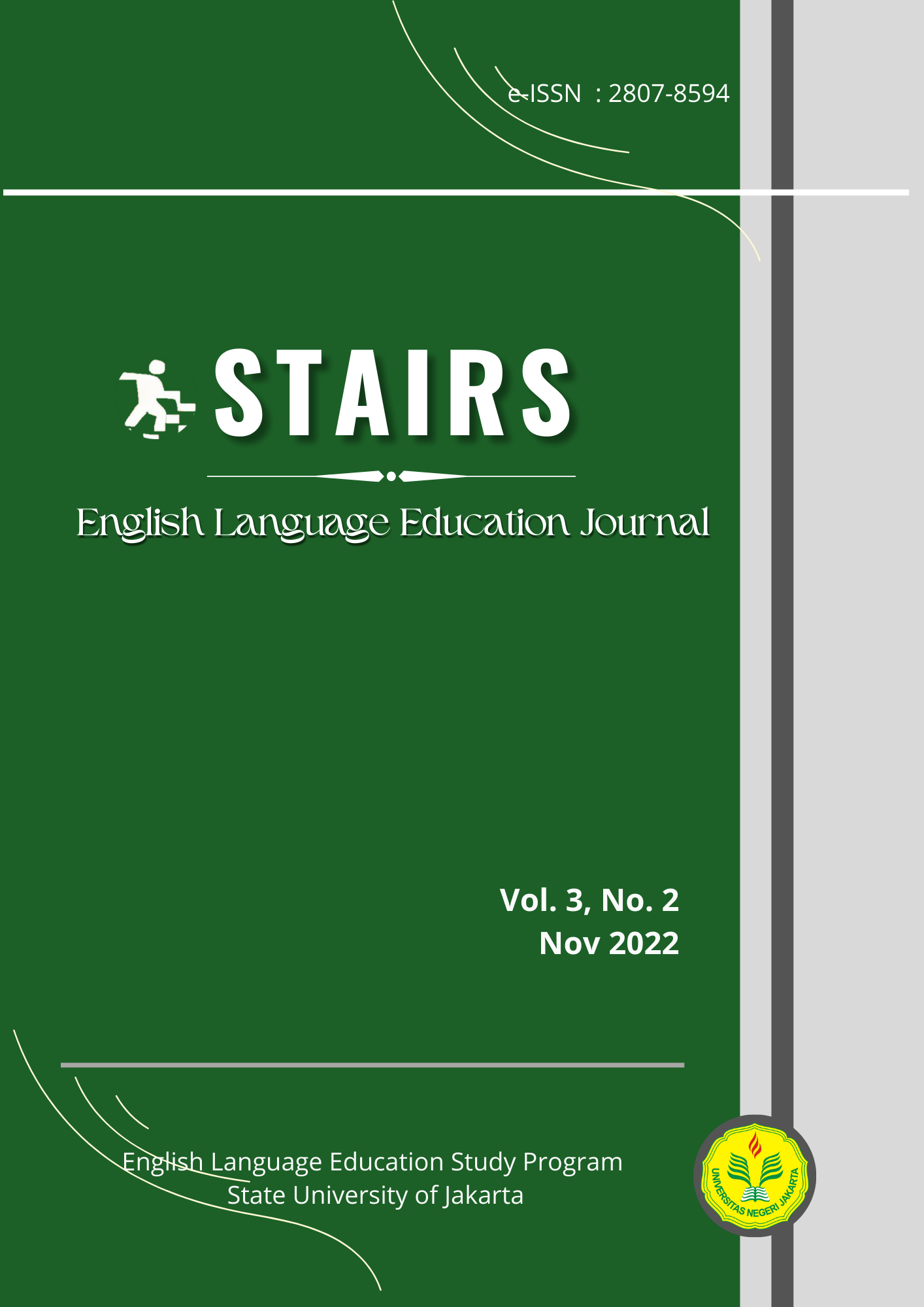Investigating Students’ High-Order Thinking Skills in Storytelling at Elementary Level: A Case Study
DOI:
https://doi.org/10.21009/stairs.3.2.1Keywords:
Case study, Elementary level, High-Order Thinking Skills (HOTS), StorytellingAbstract
The purpose of this qualitative case study is to investigate Higher Order Thinking Skills (HOTS) in speaking activities, especially in storytelling for primary school children. Data collection methods included (1) interviews to investigate the extent of HOTS understanding, implementation, tactics, students' reactions, and the impact of storytelling activities, (2) observations, and (3) documentation. An English Club teacher and the students at the elementary level served as the research's data source. Data were validated using source and technique triangulation. The interactive analysis of the Miles and Huberman model was utilized for data analysis, comprising processes of data reduction, data presentation, and drawing conclusions. The results showed that the teacher grasped the HOTS feature and used it in narrative exercises. The strategies included asking questions, allowing youngsters to work on projects, and solving difficulties. Students’ reactions toward the storytelling activities varied because their focus levels are different. HOTS components in storytelling activities such as analyzing, evaluating, and creating have a significant impact on the ability to think critically, and creatively, communicate, work together, solve issues, and boost self-confidence. Due to these diverse abilities, HOTSs help children understand the storyline better and encourage them to take risks.
References
Ahmad, A. & Parimaladevi. (2019). The implementation of Higher-Level Thinking Skills (HOTS) in History Education. Global Conferences Series: Social Sciences, Education and Humanities (GCSSSEH), Volume 2, 2019 The 2nd International Conference on Sustainable Development & Multi-Ethnic Society DOI: https://doi.org/10.32698/GCS.01100.
Azar, A.S, et.al. (2019). The Impact of HOT Skills on Enhancing Professional Communication Strategies among Malaysian TESL Students. Journal of Reviews on Global Economics, Vol. 8, Pp. 900-915.
Creswell, J. W. (2015). Research Design: Qualitative, Quantitative, and Mixed Methods Approaches [5th ed.] 9781506386706
Herdiansyah, H. (2012). Metodologi Penelitian Kualitatif untuk Ilmu-ilmu Sosial. Jakarta: Salemba Humanika.
Husain, N. (2015). Language and Language Skills. https://www.researchgate.net/publication/274310952
Ilmiyah, Z. (2020). HOTS Stimulation through Speaking Skill. Kemendikbud. 2019. Buku Pegangan Pembelajaran Berorientasi pada Keterampilan Berpikir Tingkat Tinggi.
Irvani, A. I., Warliani, R. & Fauziyyah, S.A. (2020). Analysis of Students' Problem-Solving Skills from Online Worksheets with Integration of Video Demonstration. International Summit. Science Technology and Humanity (ISETH): Reinventing Science, Technology, and Humanity for the New Future.
Juanda. (2018). Pendidikan Karakter Anak Usia Dini melalui Sastra Klasik Fabel Versi Daring. Jurnal Obsesi: Jurnal Pendidikan Anak Usia Dini, Vol. 3, No. 1.
Musliha, S., Sudana, D. & Wirza, Y. (2021). The Analysis of Higher Order Thinking Skills (HOTs) in the Test Questions Constructed by English Teachers. Advances in Social Science, Education, and Humanities Research, Volume 595 Proceedings of the Fifth International Conference on Language, Literature, Culture, and Education (ICOLLITE 2021)
Narwianta, N., Bharati, D. A. L. & Rukmini, D. (2019). The Realization of Higher Order Thinking Skills in English School Nationally Standardized Examination at State Senior High School 6 Semarang. ISET. Semarang, Indonesia DOI 10.4108/eai.29-6-2019.2290268.
Pebriana, P. H. (2017). Analisis Kemampuan Berbahasa dan Penanaman Moral pada Anak Usia Dini melalui Metode Mendongeng. Jurnal Obsesi: Jurnal Pendidikan Anak Usia Dini, Vol. 1, No. 2.
Pillay, L. A. M., Singh, C. K. S., Harun, R. N. S. R., Singh, T. S. M. M. (2018). The Implementation of Higher Order Thinking Skills for Teaching and Learning. The Journal of Social Sciences Research. DOI:10.32861/jssr.spi5.668.675
Schwab, K. (2016). The Fourth Industrial Revolution. World Economic Forum.
Sesmiyanti. (2021). The Implementation of HOTS in Teaching English Process at Tenth Grade of MTI Pasia. SALEE: Study of Applied Linguistics and English Education Vol. 2, No. 1.
Shafeei, K. N., et.al. (2017). Incorporating Higher Order Thinking Skill (HOTS) Questions in ESL Classroom Contexts. LSP International Journal, Vol. 4, Issue 1, Pp. 101–116.
Sulaiman, S. (2020). Higher Order Thinking Skill (HOTS) Pada Anak Usia Dini. SULOH: Jurnal Bimbingan Konseling, Universitas Syiah Kuala, 5(1), 1–10.
Suzuki, W. A., Feliu´-Mo´jer, X. I., Hasson, U., Yehuda, R., & Zarate, X. M. (2018). Dialogues: The Science and Power of Storytelling. The Journal of Neuroscience, 38(44):9468 –9470.
Wijayanto, B. & Nofrion. (2018). Learning Activities in Higher Order Thinking Skill (HOTS) Oriented Learning Context. Geosfera Indonesia Vol. 3 No. 2 (2018), 122-130. https://jurnal.unej.ac.id/index.php/GEOSI DOI: 10.19184/genesis.v3i2.8126.
Yaswinda, Bakhtiar, S., Maulana, I., & Irsakinah. (2021). Exploring Basic Movements of Early Childhood in Kindergarten. Indonesian Journal of Early Childhood Education Studies http://journal.unnes.ac.id/sju/index.php/ijeces. DOI: http://dx.doi.org/10.15294/ijeces.v10i2.51892.
Yen, T.S. and Halil, S.H. (2015). Effective Teaching of Higher-Order Thinking (HOT) in Education. The Online Journal of Distance Education and e-Learning, Volume 3, Issue 2
Yuliati, S.R. & Lestari, I. (2018). Higher-Order Thinking Skills (HOTS) Analysis Of Students In Solving HOTS Question In Higher Education. Perspektif Ilmu Pendidikan - Vol. 32 No. 2 Oktober 2018. DOI: https://doi.org/10.21009/PIP.322.10
Zuhriyah, M. (2017). Storytelling to Improve Students’ Speaking Skills. English Education: Jurnal Tadris Bahasa Inggris. p-ISSN 2086-6003 Vol 10 (1), 2017, 1.



